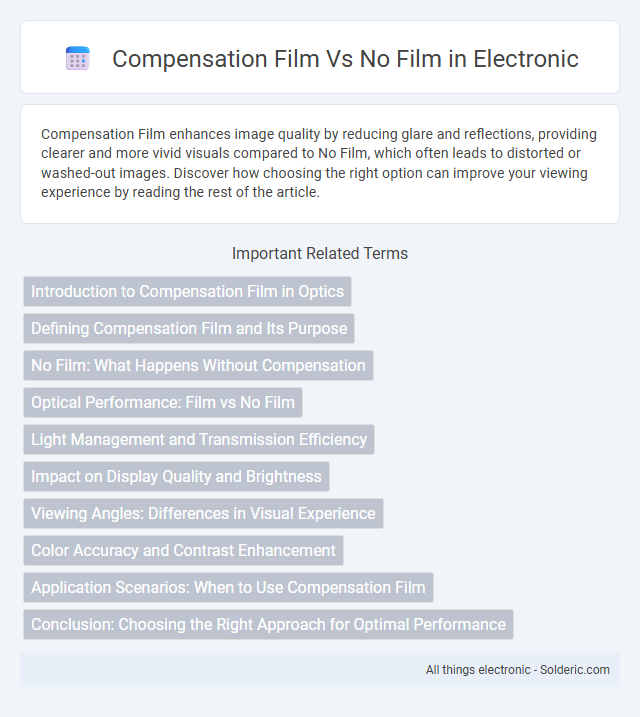Compensation Film enhances image quality by reducing glare and reflections, providing clearer and more vivid visuals compared to No Film, which often leads to distorted or washed-out images. Discover how choosing the right option can improve your viewing experience by reading the rest of the article.
Comparison Table
| Feature | Compensation Film | No Film |
|---|---|---|
| Performance Consistency | High - Maintains stable performance under varying conditions | Low - More susceptible to environmental changes |
| Protection | Enhanced - Shields against dust, moisture, and scratches | Minimal - Exposed surface prone to damage |
| Cost | Moderate - Additional material expense | Lower - No extra material required |
| Installation Complexity | Moderate - Requires precise application | Simple - Direct use without extra steps |
| Durability | Improved - Extends product lifespan | Reduced - Faster wear and tear |
Introduction to Compensation Film in Optics
Compensation film in optics refers to a specialized thin layer applied to lenses or optical components to correct phase distortions and improve image quality by balancing birefringence effects. Unlike no film, which leaves lenses vulnerable to polarization errors and reduced clarity, compensation film enhances the accuracy of light transmission and reduces unwanted reflections. Your optical systems benefit from compensation films by achieving higher precision and better visual performance in applications such as microscopy, photography, and laser devices.
Defining Compensation Film and Its Purpose
Compensation film is a specialized material applied to surfaces to counteract defects or irregularities, enhancing visual quality and performance. Its primary purpose is to balance light transmission, improve clarity, and reduce unwanted reflections or distortions in optical systems. You can achieve superior image fidelity and durability by using compensation film compared to no film solutions.
No Film: What Happens Without Compensation
Without compensation film, your solar panels may experience rapid degradation due to UV exposure, moisture, and temperature fluctuations. This lack of protective layering leads to decreased energy efficiency and a shorter lifespan, increasing maintenance costs over time. Protecting your investment with compensation film ensures sustained performance and durability.
Optical Performance: Film vs No Film
Compensation film enhances optical performance by reducing glare, improving contrast, and minimizing reflections on screens or lenses, which results in clearer and sharper images compared to no film. Without compensation film, optical surfaces may suffer from increased light scattering and unwanted reflections, leading to reduced visual clarity and eye strain. Your viewing experience benefits significantly from the improved light transmission and color accuracy that compensation films provide.
Light Management and Transmission Efficiency
Compensation film enhances light management by reducing reflection and evenly distributing light across surfaces, leading to improved visibility and reduced glare. Its high transmission efficiency allows more light to pass through, maximizing brightness without compromising clarity. In contrast, no film setups often suffer from increased light loss and uneven illumination, resulting in lower overall transmission performance.
Impact on Display Quality and Brightness
Compensation film enhances display quality by evenly distributing light, reducing glare, and improving contrast, resulting in sharper images and more vibrant colors. Without compensation film, screens may suffer from uneven brightness, hotspots, and reduced visibility under strong light conditions. Your device's display performance can significantly benefit from compensation film, especially in environments with varying ambient light.
Viewing Angles: Differences in Visual Experience
Compensation Film enhances your viewing angles by reducing color shift and maintaining consistent brightness across a wider range of perspectives compared to No Film displays. Without Compensation Film, screens tend to exhibit color distortion and contrast loss when viewed off-center, diminishing the overall visual experience. Choosing Compensation Film ensures clearer, more vibrant images regardless of your position relative to the screen.
Color Accuracy and Contrast Enhancement
Compensation Film provides superior color accuracy by filtering light to deliver more true-to-life hues and balanced tones, enhancing the overall visual experience. Without Compensation Film, images often suffer from washed-out colors and reduced contrast, making details less distinct and weakening the impact of the visuals. Your choice of Compensation Film ensures richer contrast and precise color fidelity, crucial for professional photography and high-quality imaging.
Application Scenarios: When to Use Compensation Film
Compensation film is essential in LCD manufacturing and displays requiring precise control over light polarization to improve brightness and color accuracy, particularly in devices like smartphones, tablets, and monitors. No film configurations are suitable for applications where cost reduction and simplicity outweigh the need for enhanced optical performance, such as basic digital signage or low-end displays. Using compensation film optimizes viewing angles and reduces light leakage, making it indispensable in high-quality visual applications and advanced optical devices.
Conclusion: Choosing the Right Approach for Optimal Performance
Choosing between using compensation film and no film depends on specific project goals, environmental conditions, and durability requirements. Compensation film enhances optical performance by reducing glare and improving color accuracy, making it ideal for high-precision displays and outdoor applications. Opting for no film may reduce costs and simplify manufacturing but often sacrifices enhanced visual clarity and protection, impacting overall performance.
Compensation Film vs No Film Infographic

 solderic.com
solderic.com